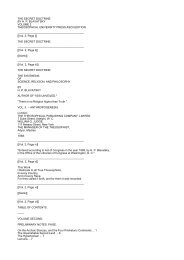You also want an ePaper? Increase the reach of your titles
YUMPU automatically turns print PDFs into web optimized ePapers that Google loves.
The Doctrine Of Eternal Life.<br />
Sacred Texts Egypt Index Previous Next<br />
THE DOCTRINE OF ETERNAL LIFE.<br />
Egyptian belief in a future life.<br />
The doctrine <strong>of</strong> eternal life in <strong>the</strong> VIth dynasty.<br />
The ideas and beliefs which <strong>the</strong> Egyptians held in reference to a future existence are not readily to be<br />
defined, owing to <strong>the</strong> many difficulties in translating religious texts and in harmonizing <strong>the</strong> statements<br />
made in different works <strong>of</strong> different periods. Some confusion <strong>of</strong> details also seems to have existed in <strong>the</strong><br />
minds <strong>of</strong> <strong>the</strong> Egyptians <strong>the</strong>mselves, which cannot be cleared up until <strong>the</strong> literature <strong>of</strong> <strong>the</strong> subject has been<br />
fur<strong>the</strong>r studied and until more texts have been published. That <strong>the</strong> Egyptians believed in a future life <strong>of</strong><br />
some kind is certain; and <strong>the</strong> doctrine <strong>of</strong> eternal existence is <strong>the</strong> leading feature <strong>of</strong> <strong>the</strong>ir religion, and is<br />
enunciated with <strong>the</strong> utmost clearness in all periods. Whe<strong>the</strong>r this belief had its origin at Annu, <strong>the</strong> chief<br />
city <strong>of</strong> <strong>the</strong> worship <strong>of</strong> <strong>the</strong> sun-god, is not certain, but is very probable; for already in <strong>the</strong> pyramid texts we<br />
find <strong>the</strong> idea <strong>of</strong> everlasting life associated with <strong>the</strong> sun's existence, and Pepi I. is said to be "<strong>the</strong> Giver <strong>of</strong><br />
life, stability, power, health, and all joy <strong>of</strong> heart, like <strong>the</strong> Sun, living for ever."[1] The sun rose each day<br />
in renewed strength and vigour, and <strong>the</strong> renewal <strong>of</strong> youth in a future life was <strong>the</strong> aim and object <strong>of</strong> every<br />
Egyptian believer. To this end all <strong>the</strong> religious literature <strong>of</strong> Egypt was composed. Let us take <strong>the</strong><br />
following extracts from texts <strong>of</strong> <strong>the</strong> VIth dynasty as illustrations:--<br />
1. ha Unas an sem-nek as met-th sem-nek anxet<br />
Hail Unas, not hast thou gone, behold, [as] one dead, thou hast gone [as] one living<br />
hems her xent Ausar.<br />
to sit upon <strong>the</strong> throne <strong>of</strong> Osiris.[2]<br />
[1. ### Recueil de Travaux, t. v., p. 167 (1. 65).<br />
2. Recueil Travaux, t. iii., p. 201 (1. 206). The context runs "Thy Sceptre is in thy hand, and thou givest commands unto<br />
<strong>the</strong> living ones. The Mekes and Nehbet sceptres are in thy hand, and thou givest commands unto those whose abodes are<br />
secret."]<br />
{p. lvi}<br />
2. O Ra-Tum i-nek sa-k i-nek Unas . . . . . . sa-k pu en<br />
O Ra-Turn, cometh to <strong>the</strong>e thy son, cometh to <strong>the</strong>e Unas . . . . . thy son is this <strong>of</strong><br />
t'et-k en t'etta<br />
thy body for ever.[1]<br />
3. Tem sa-k pu penen Ausar ta-nek set'eb-f anx-f anx-f<br />
O Turn, thy son is this Osiris; thou hast given his sustenance and he liveth; he liveth,<br />
http://www.sacred-texts.com/egy/ebod/ebod05.htm (1 <strong>of</strong> 21) [8/10/2001 11:23:20 AM]

















